Existing Conditions and Proper Fit
The following definitions and descriptions are provided to help you understand the scope of work required in replacing an underground hydraulic cylinder. You will find examples of conditions commonly encountered which bring about the need for re-drilling and/or delay progress during an underground cylinder replacement project in Items 2 though 14.
WELL HOLE (a.k.a Jack Hole)
Most underground hydraulic cylinders when originally installed were installed into a well hole that was either driven or drilled as deep as the travel of the elevator. Generally speaking you can say the hole is nearly as deep as the building is tall. The width of the hole is determined by the size of the cylinder needed for the particular elevator which varies based on the capacity of the elevator.
EARTH CASING
Once the well hole is drilled, an earth casing is often required to maintain the integrity of the hole. The earth casing is a large steel pipe having an inside diameter several inches larger than the hydraulic cylinder planned to be used. Earth casings are most commonly used to prevent caving found where well holes are driven-or drilled into sand, clay or soil conditions that are not obstructed by rock or ledge.
ROCK or LEDGE
An earth casing is not always possible in cases where rock and ledge are encountered. In these cases well holes are driven or drilled to diameters sufficient to accommodate only the underground hydraulic cylinder without the use of an earth casing. Rock and ledge holes tend act as an earth casing in and of themselves.
GROUND WATER
Many installations required the use of special water stop rings and hydraulic cements to prevent ground water from penetrating the elevator pit from below. If water is encountered we will need special pumping equipment and a place to divert the water while work is being performed.
BACK FILLED WITH SAND
Nearly all installations have the air space between the earth casing and hydraulic cylinder back filled with sand. All Stanley installations have the entire height of the space filled. Some other installers only partially filled this space. Once the existing cylinder is removed from the well hole, this sand must he removed before the new replacement cylinder is installed. This process is commonly referred to as “Cleaning Out the Hole”. In cases where cylinder leaking occurred this sand is normally contaminated with oil requiring special containerization and removal in accordance with EPA regulations.
BACK FILLED WITH CONCRETE
The air space between the earth casing and hydraulic cylinder is back filled with hydraulic cement when heavy water conditions are involved. When we encounter this condition the only way to remove the cylinder is by drilling the concrete out and working the cylinder free. Once it is removed we need to remove the remaining debris from the hole This process is commonly referred to as “Cleaning Out the Hole”. In cases where cylinder leaking occurred this debris is normally contaminated with oil requiring special containerization and removal in accordance with EPA regulations.
WILL A NEW CYLINDER FIT?
The new cylinders proposed for use today require a larger hole than was originally installed. The added PVC or HDPE protection makes the cylinders several inches wider and as much as twelve inches deeper. In many cases we have drilling reports from the original installation that help us to anticipate existing conditions and the likelihood of proper fit. This however does not assure that a replacement cylinder can be installed without re-drilling a new hole. When the existing cylinder is removed the side wall integrity of the existing jack hole can be weakened resulting in “caving” which can make it particularly difficult to reinstall a new cylinder without re-drilling.
“If you rely on an elevator, you can rely on Stanley!”
Non-Rock – Driven or Drilled
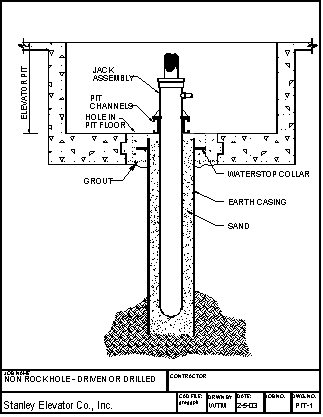
Many cylinders were installed in jack holes that were driven or drilled into sand, clay or soil conditions that are not obstructed by harder rock or ledge. The usability of the hole is then determined by the diameter of the existing casing and depth of the hole. Generally speaking the deeper the hole the more difficult the re-installation is. Often times the only choice available is to re-drill a new hole using an inside drilling rig.
Non-Rock Driven or Drilled Out of Plumb
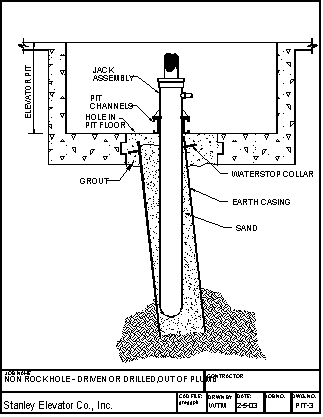
Many cylinders are installed in jack holes that were driven or drilled into sand, clay or soil conditions that are not obstructed by harder rock or ledge. These types of conditions, though often easier to penetrate, can “walk” making it difficult to accomplish a plumb hole. This can prevent the new larger diameter cylinder from having sufficient clearance to be installed “plumb”. This may require pulling the existing casing and drilling a new hole.
Non-Rock Driven or Drilled with Crimped Casing
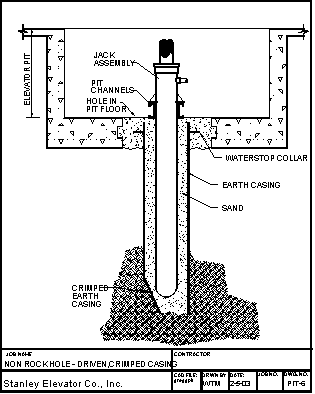
Many cylinders are installed in jack holes that were driven or drilled into sand, clay or soil conditions that are not obstructed by harder rock or ledge. This driving process can cause the earth casing to become “crimped”. This can prevent the new larger diameter cylinder from having sufficient clearance to be installed “plumb”. This may require removing the existing casing and drilling the hole.
Non-Rock Driven or Drilled Out of Plumb with Sealed Bottom
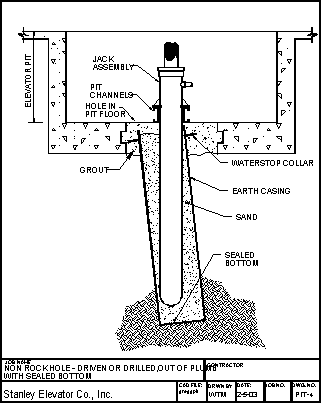
Many cylinders are installed in jack holes that were driven or drilled into sand, clay or soil conditions that are not obstructed by rock or ledge. At times the earth casing originally installed may have sealed bottoms making it impossible to install a new longer replacement cylinder without removing the earth casing and re-drilling the hole. The installation of sealed bottom earth casings may have resulted in out of plumb conditions that prevent the new larger diameter cylinder from having sufficient clearance to be installed “plumb” without re-drilling the hole.
Non-Rock Driven or Drilled with Sealed Bottom
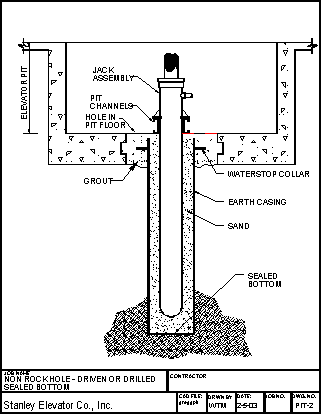
Many cylinders are installed in jack holes that were driven or drilled into sand, clay or soil conditions that are not obstructed by rock or ledge. The existing hole may be plumb but some times the earth casing originally installed may have a sealed bottoms making it impossible to install a new longer replacement cylinder without removing the earth casing and re-drilling the hole
Lack of Existing Earth Casing
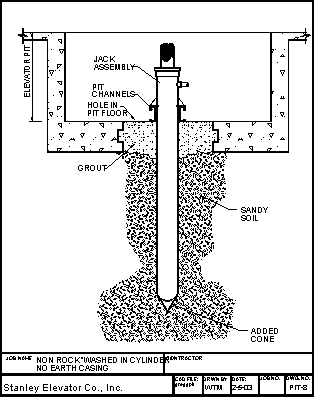
Some cylinders were installed in jack holes that were washed into sand, with compressed air jets and no drilling rig or earth casing was used. These types of conditions, though rarely encountered, have no side wall integrity resulting in caving. This can make it difficult to re-install a new cylinder after the old one is removed. Drilling and special casing arrangements will be required to install a new replacement cylinder.
Rock Hole with Single Water Collar
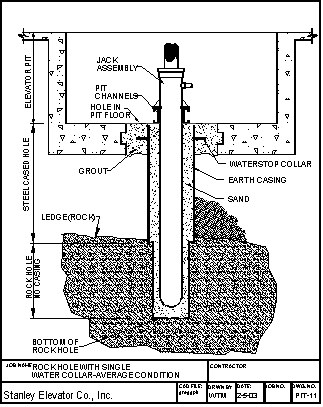
Many cylinders are installed in jack holes that are driven or drilled into rock or ledge. Some installations required the use of special water stop rings and hydraulic cements to prevent ground water from penetrating the elevator pit from below. If water is encountered we will need special pumping equipment and a place to divert the water while work is being performed.
Rock Hole with Single Water Collar Drilled to Exact Depth
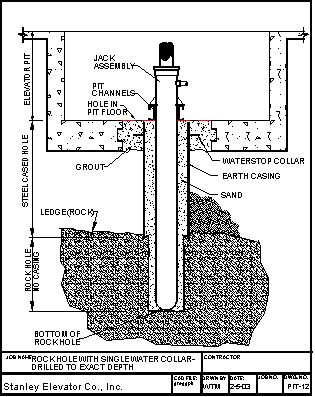
Many cylinders are installed in jack holes that are driven or drilled into rock or ledge. These types of conditions though often harder to penetrate commonly have little if any side wall caving, many of these holes were drilled to very close clearances which can make it difficult to reinstall a new larger diameter cylinder without re-drilling the hole first. The new replacement cylinders are several inches wider and as much as a foot longer than the existing cylinder. This will require that the hole be re-drilled to satisfy the new cylinder size. Many installations required the use of special water stop rings and hydraulic cements to prevent ground water from penetrating the elevator pit from below. If water is encountered we will need special pumping equipment and a place to divert the water while work is being performed.
Rock Hole with Single Water Collar Drilled Out of Plumb
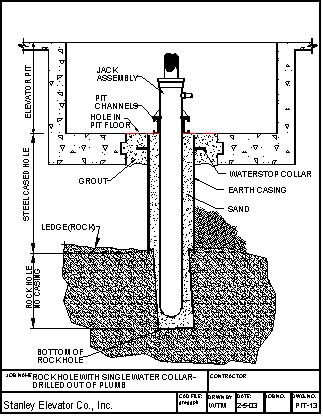
Many cylinders are installed in holes that were driven or drilled into rock or ledge. These types of conditions though often harder to penetrate, have little if any side wall caving. Many of these holes were drilled to very close clearances, which can make it difficult to reinstall a new larger diameter cylinder without re-drilling the hole first. These close clearances are particularly difficult to overcome when the original hole was drilled out of plumb. When a rock whole is out of plumb the new larger diameter cylinder can not be installed without re-drilling the hole first. Many installations required the use of special water stop rings and hydraulic cements to prevent ground water from penetrating the elevator pit from below. If water is encountered we will need special pumping equipment and a place to divert the water while work is in progress.
Double Cased Hole with Single Water Collar
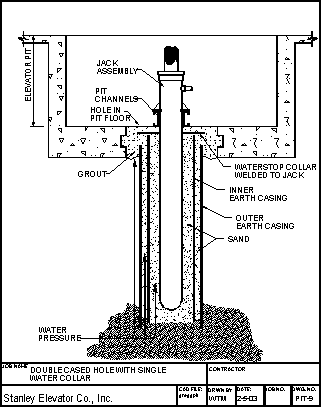
Many cylinders are installed in jack holes that were driven or drilled into sand, clay or soil conditions to a depth where the drilling was obstructed by rock or ledge. When rock or ledge was encountered a second drilling or drive method was used, often times resulting in a smaller diameter hole. Many times, in these cases a second earth casing would be utilized inside the original larger earth casing. This is referred to as a double casing installation. Many installations required the use of special water stop collars and hydraulic cements to prevent ground water from penetrating the elevator pit from below. When water is encountered we will need special pumping equipment to divert water while work is being performed.
Double Cased Hole with Double Water Collar and Sealed Bottom Inner Casing
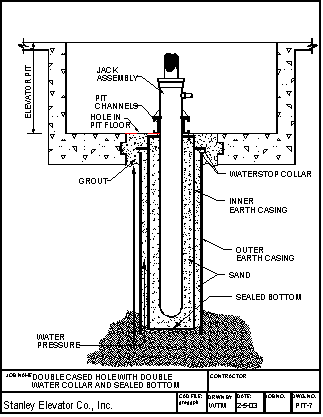
Many cylinders are installed in jack holes that were driven or drilled into sand, clay or soil conditions to a depth where the drilling was obstructed by rock or ledge. When rock or ledge was encountered a second drilling or drive method was used, often times resulting in a smaller diameter hole. Many times, in these cases a second earth casing would be utilized inside the original larger earth casing. This is referred to as a double casing installation.
When severe ground water conditions were encountered installations often required the use of a second special water stop collar and hydraulic cements to prevent ground water from penetrating the elevator pit from below. These conditions require more extensive clean up techniques and when water is encountered we will need special pumping equipment to divert water while work is being performed.
“If you rely on an elevator, you can rely on Stanley!”
Rock Driven with Fractured Sides”
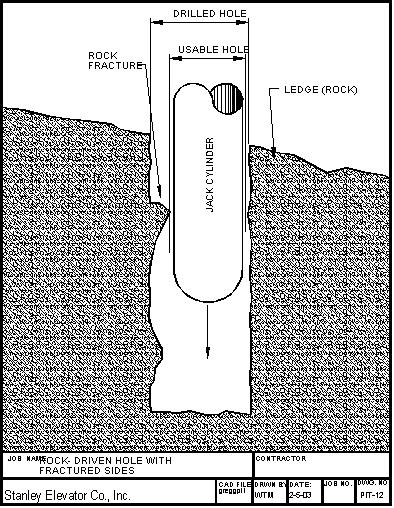
Many cylinders were installed in jack holes that were driven or drilled to into rock or ledge. These types of conditions, though often harder to penetrate, commonly have little if any side wall caving. They do however have what are referred to as “side wall fractures”. Since these holes were driven to very close clearances the fractures can make it difficult to reinstall a new larger diameter cylinder without re-drilling the hole first.
Rock Rotary Drilled with Kerf Edges
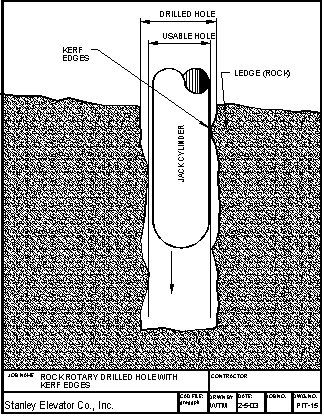
Many cylinders are installed in jack holes that were driven or drilled into rock or ledge. These types of conditions, though often harder to penetrate, have little if any side wall caving. They do however have what are referred to as “Kerf Edges”. Since these holes were drilled to very close clearances these kerf edges can make it difficult to reinstall a new larger diameter cylinder without re-drilling the hole first.